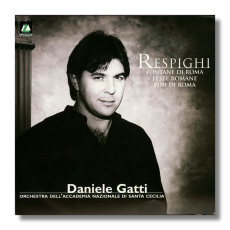
The Internet's Premier Classical Music Source
Related Links
- Respighi Reviews
- Latest Reviews
- More Reviews
-
By Composer
-
Collections
DVD & Blu-ray
Books
Concert Reviews
Articles/Interviews
Software
Audio
Search Amazon
Recommended Links
Site News
 CD Review
CD Review
Ottorino Respighi

Roman Triptych
Symphonic Pictures
- Fontane di Roma (1917)
- Feste Romane (1929)
- Pini di Roma (1924)
Orchestra dell'Accademia Nazionale di Santa Cecilia/Daniele Gatti
Conifer 75605-51292-2
This disc got very high praise in the July issue of Gramophone in 1997. On the other that same journal, a couple months later, panned one of th finest recordings of Shostakovich's 11th I have heard. So, with some skepticism I requested it for review. I compared it, specifically the Catacombs section, with recordings by Batiz on Naxos, Jansons on EMI an Tortelier on Chandos. While I might not place this in the pantheon of one of the greatest recordings ever (let's face it, the music isn't great music) it is certainly worthy of the praise it got.
One of the interesting things I checked is the difference, if any, that using 20-Bit technology makes. I have been noticing, and writing, for some time that the 20-Bit method provides a much more realistic, cleane focused, warmer sound than does 16-Bit. Well, here is more evidence. What puzzles me is that the recording companies are not crowing about its inherent superiority….I'd expect to see it more flouted on covers (as it is in some cases, like Chesky). If I had to live with only one Roman Trilogy it would be this one and the sound is not the only reason….but certainly plays a part in that decision.
Let me take you on a tour of the different recordings using the Catacombs section for reference. Of the three versions, Gatti's is the slowest, in one case by a considerable margin. Gatti's 7:39 contrasts with Jansons' 7:35, Tortelier's 6:33 and Batiz's 5:28!!! The Conifer recording has a humongous dynamic range. The opening is sensed before it is really heard. While slow, it does not sound it. Gatti pulls bac at moments, like at 4:30, just enough to add to the tension. The march creeps in like an omen and is more stately than in Batiz's recording. The tam-tam more recessed than on the Naxos recording, but it is still powerful. The Batiz recording offers a brighter sound with less range, and it is exciting. The march is insistent, threatening, the tam-tam a the close of the Catacombs is a drenching experience. Over time the sound may be a bit trying on the ear…but that is only a maybe. The off-stage trumpet in the Batiz is really too forward, Jansons gets this the best, but over-all his sound and interpretation is not as memorable as the other two. Chandos provides its ususal sumptuous sound (the Ormandy Philadelphia satin finish) for Tortellier and the performance i good, but it is not in the same class as Batiz or Gatti. The whole thing is a bit detached, as if watching a movie of it in Technicolor. It is powerful like a distant god.
In sum, I like all four recordings. Each offers a different perspectiv on these works. If asked which ones I'll more likely return to, however, I would have to say it is the Gatti and the Batiz. I fear my earlier praise for the Jansons issue has now been qualified by this experience.
Back to the Gatti. The sound here is really spectacular. Stokowski once said that some day it would be possible to make recordings that were better than concerts. I think this is evidence that he was right. There is a fresh air around the music, the decay is natural, the reverberation just right. The organ underlines the catacombs' march such that your body feels it. This performance is as emotionally draining, but much different, as Batiz's.
Later thoughts: I have just listened to the entire disc again. Gatti consistently gets it right. The individual moments include, to name just a couple, the eerie 'gong' in the second section of Feste Romane and the glissando on the xylophone (is that it???) in the fourth section. The woodwinds throughout are delicious. This orchestra gave the initial premières of two of the works and the Italian première of the Feste Romane. Conductor and orchestra come together in a gestalt where they sound like they are exploring this music anew and enjoying every bar of it; that this is music they believe in and love.
Sound is important but not everything. RCA also released a Ravel disc with Maazel conducting the Vienna Philharmonic. This is a great orchestra and the sound is stunning, but it cannot salvage a pedestrian performance from a peripatetic conductor. No, this Respighi disc's recommendation has as much to do with the conductor as with the sound. Imagine the same conductor and sound in Ravel…hmmm.
A digression: On the other hand, both discs feature a large photo of the conductor on the cover. Gatti's name is less prominent, but his hirsute chest and young Italian looks explain why Conifer chose this hook. Still, I'd rather see the music stressed rather than the conductor. The insert notes for this Conifer release are very good, if not memorable.
Copyright © 1998, Robert Stumpf II


















